Heat Pumps
Heat pumps seem too good to be true. You get out more energy than you put in? What’s going on?
Essentially the heat pump works by taking energy from one place and “pumping” it to another. So to heat a house, instead of using energy to generate heat directly, we use the energy to concentrate and pump heat from somewhere else. You pay for a lot less energy to pump heat around, rather than create heat. So we get things like heat pumps with 400% efficiency (or a coefficient of performance (COP) of 4, compared to an electric heater with a COP of 1).

These young ladies are very excited about heat pump COP numbers! Read down to geothermal power for further details.
High School Physics [feel free to skip this if memories of high school make you nervous]
Going back to some high school physics; the heat pump works like a refrigerator. There is a source of energy, a medium to pump the heat around, and a destination for the pumped energy. In the case of the fridge, the energy source is the heat contained in the food and drink in the fridge. The medium is the refrigerant that circulates through the pipes. The energy destination is the set of radiation coils at the back of the fridge, which essentially dump the unwanted heat into the air behind the fridge.
The trick to the whole thing is to compress and decompress a medium with the right properties. When material changes state from liquid to gas it takes in extra energy – the “latent heat of vaporization”. That energy comes from whatever surrounds the medium – a pipe of some sort and then whatever that pipe is immersed in; like the interior of the fridge. Alternately when it changes from gas to liquid, the medium gives up that heat and so heats the surroundings. To make the medium change state we compress it (i.e. increase the pressure), where we want heat, and decompress it, via an expansion nozzle, where pressure can drop rapidly, where we want cool (i.e. a reduction in heat).
There are lots of explanations and diagrams available. For clarity I like this one from Virginia Tech. http://www.geo4va.vt.edu/A3/A3.htm
Nomenclature
Somehow the language around heat pumps has become confused. Before stating what we will use throughout this site, let me recap the basic principles:
- A heat pump uses a medium to transport energy from one area to another
- There is a source of energy
- There is a destination for the energy
This is obvious when we are talking about heat being pumped into a building. We get heat energy from somewhere in the environment and pump it into the house. However if we want to cool the building the source of energy, being strictly correct, is air inside of the house and we want to transport that energy to the outside surroundings.
To simplify matters let’s call the “source” the source of what we want to achieve – i.e. heat in winter, cool in summer. The medium we can ignore – it’s of great importance to the engineers and designers but we can take it for granted. The destination is the inside of the house, and will be heated (or cooled) air or water that is distributed around the house – through air ducts, baseboard, radiators or under-floor piping.
Heat pumps are classified by source!
Air-source heat pumps
- Take the energy from the surrounding air
- Mostly called just “heat pumps” in most US advertising literature
- They are the boxes with grilles at the sides and a fan on top that sit next to the house and provide air-conditioning
- They take energy from the air inside the house (by evaporation of the medium) send the heated liquid out to the unit, compress it there and dump the generated heat into the outside air.
- In reverse cycle mode they do the opposite, take energy from outside (so cooling the outside air) and dumping the heat inside.
Ground-source heat pumps
- Take energy from the ground
- The energy needs to enter (or exit) the medium by a series of pipes buried in the ground. The pipes are called a ground loop.
- There are many ways to lay the pipes, but it breaks into three main categories:
- Deep Holes, going down 150 to 500 feet (50 to 150 meters). Pro: no need for a large property, steady temperatures at that depth. Con: expense of the deep drilling and may need special permits as the drill may hit ground water, or infringe on gas/oil leases.
- Horizontal Layout; a loop of pipes laid horizontally, just below the frost line. Pro: cheapest method, simple. Con: needs a relatively large area, makes a huge mess of the landscape if retrofitting to an existing building.
- Spiral Collectors; spiral pipes laid in bore holes. Pro: Still a simple solution, makes less of a mess of the garden, needs less area than the horizontal layout. Con: Expense and need to get experienced installers.
-
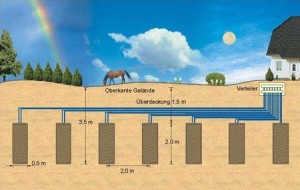
Diagram of a vertical spiral layout. The top of the spiral is below the frost line, about 5′ here. The spiral is 6′ and a bit high, 1.5′ in diameter and spaced something over 6′ apart.
- The efficiency of the heat pump depends on the ground being able to provide (and absorb) heat. Even frozen ground can still provide heat energy, but ideally the pipes are laid below the frost line where they will be at an even temperature all year – warm in comparison to air temperatures in winter, and cool compared to ambient in summer.
- Efficiency further depends on soil composition, conductivity and the presence of ground water – more water is better.
- This site links to a paper by Carrier corporation on ground-source heat pumps. It is of course a Carrier marketing piece but the information is valid.
In the US ground-source heat pumps are commonly called “geothermal”. This is very confusing. Ground-source heat pumps do not rely on hot rocks or geysers! The word geothermal should only be used for energy systems, usually of an industrial scale, that work with high temperature sources such as hot rocks, geysers and the like where the energy comes from the earth’s mantle.

“Geothermal” has a major advantage over “ground-source heat pump” – it makes for much better pictures! Like this geothermal application in Iceland, …
Water-source heat pumps
- Much the same as ground-source, but the pipes full of medium are suspended in water; a pond, lake, river or ocean.
- More efficient than ground-source as water will transport energy to (from) the pipes circulating the medium more efficiently than the equivalent ground-source system.
- Much less common in residential applications because few of us live near a large enough body of water. Even if we do and the water is shared with others the practical and legal hurdles for water-source heat pumps are staggering. If you own your own lake or large pond it’s the most efficient!
Following the naming principles a fridge then is a “food-source heat pump”… (sorry – I get carried away by the logic sometimes)
Other factors
In this simple discussion we have skipped over a lot of items, especially how the “medium” actually exchanges energy with the source and destination. There are primary and secondary loops, heat exchangers, open and closed systems etc. It is a large subject in itself and discussed in some of these articles:
- Wikipedia – note that the heading of this article (Geothermal heat pump) is misleading, and refuted inside the article and the discussion that goes with it. (Update January 2022: I see Wikipedia changed the heading to “Ground Source Heatpump”. Just goes to prove that the forces of right win sometimes.
- Wikipedia – on heat pumps, again with the misleading “geothermal” use in the article
- Virginia Tech Update January 2022: this site appears to be not available.
- Update January 2022: Here is a glossary from Green Foot Energy in Canada: https://www.greenfootenergy.ca/resources/heat-pump-glossary
Ground-source air “tempering”
Another way of utilizing ground source energy is to run air for a ventilation system, fitted with a heat recovery ventilator (HRV), through a pipe laid in the ground. This tempers the incoming air, warming it in winter and cooling it in summer, so that the HRV can run at higher efficiency. This is not geothermal, and is not a heat pump application. The discussion around the pro’s and con’s belongs in the Ventilation section of this site. However the realist has not seen one of these “air wells” in action and still has concerns about condensation, mold and other contaminants in the pipe. The inlet of course needs to be covered and fitted with insect screens and should be provided with filters. The HRV has filters as well. So all should be fine, but I see newer designs for air wells more complex than a simple pipe, in part to deal with the contamination issue.
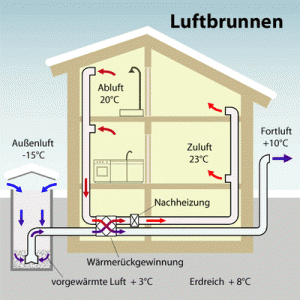
In this diagram outside air at 5 degrees F enters the air-well (German: “Luftbrunnen”). The ground is at 46F. The air is prewarmed to 37F. It goes through the HRV, through a heater and passes into the house at 73F. It exits the rooms at 68F, goes back to the HRV and is finally exhausted at 50F.
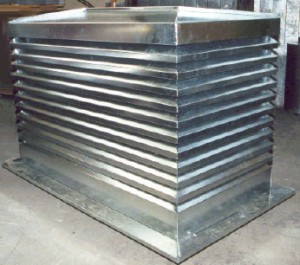
If you like the pipe idea better, then this is what the intake could look like. Plenty of room for filters etc. Open on all sides. Don’t forget it has to be raised so that it will not be clogged by snow.
Summary
Heat pumps transfer heat energy from one place to another. For accuracy we name them by the source of the heat for heating purposes and/or the destination of the heat if used for cooling.
In order of best efficiency they are:
- Water-source heat pumps
- Ground-source heat pumps
- Air-source heat pumps
Unfortunately efficiency comes at a price so the most commonly installed and available are air-source heat pumps as found in air-conditioners, fridges and dehumidifiers. Water-sourcing is rarest, despite the higher efficiency, because of the lack of access to adequate bodies of water by the average home owner.
Ground-source heat pumps are commonly called “geothermal” in the US. This is a confusing misnomer, because heat pumps do not rely on the deep earth, high heat of the earth’s mantle.
Ground-source conditioning of air as part of a ventilation system makes use of the same energy capacity of the ground as a ground-source heat pump but lacks the actual recirculation mechanism of the true heat pump.
3 responses to “Heat Pumps”
Leave a Reply
You must be logged in to post a comment.






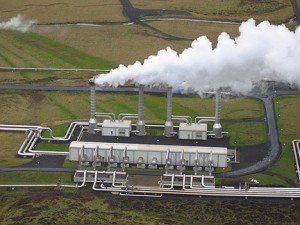
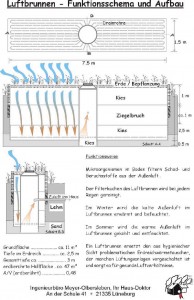

i have MSc in Mechanical engineering/sub-field: energy conversion
i want to perform a numerical simulation of vertical spiral ground source heat exchanger
could you help me?
i want to know that would you have any experimental data about this kind of heat exchanger? or give me any adders to found it?
I have no direct knowledge. A quick web search shows me:
ftp://ftp.aidea.org/Geothermal/vertical%20gshp.pdf and
econpapers.repec.org/RePEc:eee:appene:v:78:y:2004:i:2:p:231-245
http://xbywb.tjujournals.com/Upload/PaperUpLoad/34c42c62-f4cd-44a1-94e1-5a991ea2a4a1.pdf
Good luck
Update January 2022:
I received an email from Stephanie at Green Foot Energy Solutions of Canada to add their heat pump glossary to this page. Happy to do it. Here’s it is:
https://www.greenfootenergy.ca/resources/heat-pump-glossary
Also as an update in the page itself (above).